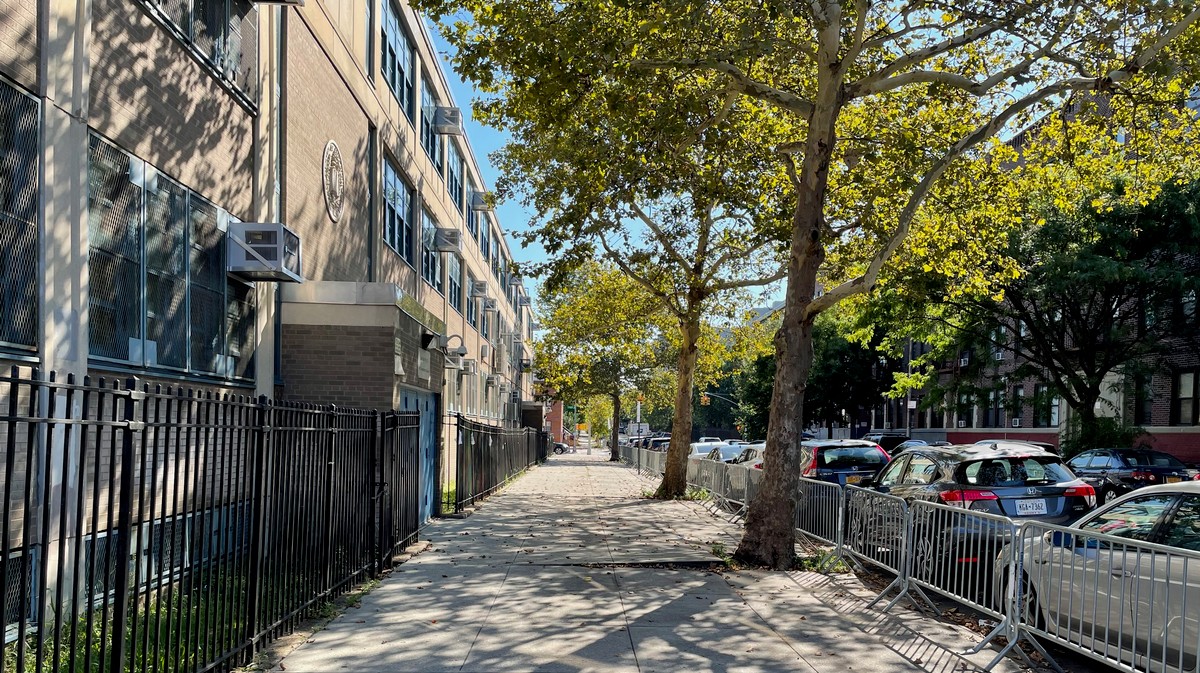- cross-posted to:
- globalnews@lemmy.zip
- cross-posted to:
- globalnews@lemmy.zip
It took a lot of hard work, a little bit of luck, and one obstructionist officer to leave for cops to stop parking on a Brooklyn sidewalk.
On Monday, September 11, Robb Mandelbaum was biking with his kids to school at the Brooklyn Green School in Crown Heights. They were running late so they took the most direct route, on St. Marks Avenue. Mandelbaum has always avoided St. Marks. For more than 40 years, cars have parked on the school’s sidewalk perpendicularly to the curb, backing up so the rear bumper is nearly touching the school’s fence, blocking the entire sidewalk, forcing children to walk in the middle of the road to get to school.
Among the cars routinely parking on the sidewalk were officers from the adjacent 77th precinct of the New York Police Department. For years, despite student activists and official attempts to enforce the parking laws on that block, nothing changed.
Then, all of a sudden, it did.
On Monday, Mandelbaum was “astonished,” he told Motherboard in a recent interview. Metal barricades had gone up along the curb. On the fence, flyers with NYPD watermarks declared “NO ANGLE PARKING ALLOWED! PARALLEL PARKING ONLY!” The sidewalk was clear.
“I was shocked,” Chi Ossé, the city councilmember representing the district, said, and then repeated himself for emphasis.
It is illegal to park a car on or across a curb in New York City, subject to a $115 fine. But this doesn’t stop thousands of cars across the city from doing it every day. Cars park in playgrounds, in parks, on sidewalks, in bike lanes, and almost any other place a driver feels like parking. Many do so while displaying a placard—a widely abused piece of paper for vehicles purportedly on official business that gives the driver free parking, both legal and illegal—or any other vaguely official-seeming item in order to avoid repercussions. A Streetsblog taxonomy of placard abuse found four different categories of placards consisting of 37 different items, ranging from official placards to handwritten notes and traffic cones, all within one Manhattan neighborhood.
But when it comes to sidewalk parking, nobody does it better than New York’s Finest. A study published earlier this year, in which PhD student Marcel Moran visited every single NYPD precinct, found that cops parked on the sidewalks at 70 of 77 precincts. Moran found the sidewalk parking was, in many cases, a permanent fixture, documented on Google Street View as far back as the images go, and in some cases documented in newspaper articles from the 1980s and 90s. Such was the case outside the 77th precinct; a school Instagram post celebrating the new barricades said cars had been parked on that sidewalk for more than 40 years, and they can be seen in the earliest street view images from 2012.
With sidewalk parking such an intractable problem, how did the Brooklyn Green School clear their sidewalk of parked cars? With a lot of hard work and a little bit of luck.
“It was not easy at all,” said Ossé. “It was like pulling fucking teeth to get this done.”
The Brooklyn Green School, a middle school with a social change and ecology focus, opened in 2018 and shares a building with PS 335. As part of the school’s curriculum, students pick an issue to research and organize around. The year the school opened, they picked the issue of cars parking on the sidewalk outside of the school as one of the first things they wanted to change. They wrote letters, made calls, and asked for help. For years, they got nowhere.
Things changed, according to Mandelbaum, in early 2023 when Ossé took office. On January 26, Mandelbaum wrote Ossé an email explaining the issue.
“The sense of impunity is breathtaking,” Mandelbaum wrote. The problem wasn’t just the cops, but that the cops parking on the sidewalk signaled to the entire neighborhood that they could, too, and subsequent years of no enforcement only cemented the tradition. Mandelbaum reserved particular ire for a red Jeep that routinely parked on the curb cut—the red strip at the intersection corner—which is required by the Americans With Disabilities Act so people in wheelchairs or using walkers or canes can more easily cross the street. The Jeep displayed an FDNY “Fleet Services” placard, according to photos Mandelbaum took and seen by Motherboard.
“I know of no other block in the neighborhood where anything to this degree happens,” Mandelbaum said in the email, “especially one with a school serving over 300 children. What can we do to put a stop to this?” He added that, “Even if the police won’t abide by the rules, the least they could do is enforce them for others. It’s a terrible thing to say, but I would settle for that if it brought a measure of safety to the street.”
Ossé replied four days later, promising to call the inspector of the 77th precinct. On January 31, the day after Ossé called, a letter signed by Deputy Inspector Tony Brown of the 77th Precinct appeared on every car on the block. But the tone was not what Mandelbaum or Ossé had imagined.
The letter’s stated intent was to “bring to your attention the complaints that the precinct has been receiving about the parking conditions of the block.” The leaflet informed car owners “we can no longer have illegal parking (i.e. double-parking, angled parking where not permitted, vehicles without license plates, etc…) on Saint Marks Avenue.” The apparently sympathetic police said that they “understand the inconvenience that this may cause due to the multiple vehicles on the block” and warned “strict enforcement of parking regulations” will begin next week.
But it didn’t. Through the rest of the school year, Mandelbaum and the Brooklyn Green School’s principal, Marcella Carr-Gay, periodically updated Ossé to report nothing had changed.
After more prodding by Ossé, in late June, Deputy Inspector Brown scheduled a meeting with Ossé with an unusual requirement that the police union representatives also attend.
“Unclear why the PBA needs to be present for a parking issue that the precinct command refuses to enforce—and claims is the fault of teachers and residents—we still acquiesced in an effort to move the needle,” Naomi Hopkins, Ossé’s chief of staff, wrote to Mandelbaum in an email. Mandelbaum asked what the point of the meeting was and what the NYPD was actually saying.
“I hate to speculate but it seems to me that avoiding enforcement is what this meeting will be about,” Hopkins wrote back. “Why else would a union need to be present?”
In an interview, Ossé said the intent of the meeting was to “scare us a little bit” and to argue that the NYPD had a right to park on the sidewalk and that if they went through with the changes the entire neighborhood would be mad at them. The NYPD did not respond to a request for comment on this meeting or anything else in this story.
According to Ossé, the big breakthrough was the departure of Deputy Inspector Brown. The Friday before the barriers disappeared, Ossé attended an African American Clergy event and brought the sidewalk parking up with the chief of Brooklyn North, Scott Henderson.
“And on Monday,” Ossé said, “the cars were gone.”
The 77th Precinct didn’t respond to a Motherboard request for an interview or comment. When asked about the letter and all the other details reported in this story, a spokesperson for the NYPD told Motherboard, “Brooklyn Green School officials reached out to 77 Precinct personal [sic] regarding parking on the sidewalk along a portion of Bergen Street. As a result, metal barriers were placed along the curb midblock on Bergen Street to Rochester Avenue on Monday, September 11 to prevent precinct personnel and residents from parking there. Vehicles since then have begun to park parallel to the curb in that area.”
To be clear, there is still sidewalk parking on St. Marks Avenue. The barricades only cover the length of the school. There is a playground and small park next to the school, and when I went by on Thursday, September 14, there were cars parked along the sidewalk next to the playground. Likewise, there were cars parked on the sidewalk outside the precinct half a block up, and plenty of illegally double-parked cars around the precinct as well, including squad cars and other official NYPD vehicles, even though the police station has its own parking lot.
Nevertheless, the block is obviously much safer, more pleasant, and cleaner than it used to be, because the parked cars caused garbage to pile up on the sidewalk and prevented street sweepers from accessing the curb.
“What the cops finally agreed to do,” Mandelbaum said, “is throw the civilians under the bus.” As Mandelbaum sees it, the cops are now enforcing a previously implicit double standard. “So the cops still sort of violate the law,” he said, because they still park on the sidewalk on other parts of the block, “but now they made it so no one else can.” This was the outcome Mandelbaum envisioned when he first emailed Ossé back in January.
I asked Ossé what other councilmembers or civilians who want the NYPD to enforce sidewalk parking rules could learn from this saga. He said that being persistent and having the councilmember on their side is key.
“It was just something that really pissed me off,” Ossé said.


